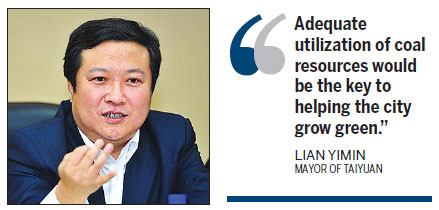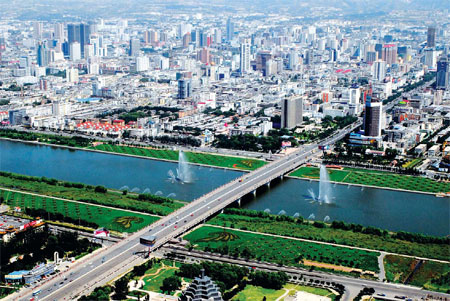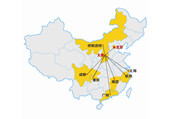Taiyuan shifting to greener growth model
By Zhong Nan in Beijing and Sun Ruisheng in Taiyuan, Shanxi province ( China Daily )
Updated: 2012-11-05
|
Due to the dominance of coal in the local economy, Taiyuan was once heavily polluted. But, after years of industrial restructuring and upgrading, the city has changed its image. Photos Provided to China Daily |

After years of rapid growth driven by coal mining and the energy industry, Taiyuan, capital of China's coal-rich Shanxi province is shifting to a greener developing model.
While many Chinese cities, especially in coastal regions, were struggling to boost manufacturing and exports in the first half of this year, Taiyuan, achieved 104.47 billion yuan ($16.7 billion) in GDP during the same period, a 9.7 percent rise from a year earlier, according to the latest economic data released by the Shanxi provincial government.
Coal has driven the economy of Taiyuan and Shanxi province for decades, but at the same time, it is one of the major sources of pollution. To change the focus of its model from polluting industries to those with high added value, Taiyuan is leading the nation's resource-dependent cities in industrial reform.
Because China demanded more energy, mining and industrial materials for economic development during the period of the nation's 11th Five-Year Plan (2006-2010), Taiyuan's industrial structure was still dominated by coal-related industries, such as power grids, aluminum, iron and steel manufacturing.
The proportion of its economy devoted to high-tech, green and service industries was small compared to that of coal-related industries.
The city was not an isolated case in China. The nation has more than 110 resource-dependent cities, two-thirds of which are plagued by a damaged environment, an imbalanced pattern of economic development, exhausted mines and surging unemployment rates.
Coal consumption is a major cause of pollution in the city, with more than 70 percent of sulfur dioxide emissions traced to the burning of coal. Moreover, widespread use of coal in an inefficient way, such as through coal-powered stoves and heating units, has also threatened people's living environment.
Preferential policies
With a plan proposed by the Shanxi provincial government and officially approved by the State Council in September, the province has mapped out a slew of preferential measures, including reforms to the coal tax, the fostering of substitute industries and the initiation of environmental protection projects.
"This move helps Taiyuan establish a balanced economy and further diversify its industrial categories, increase production efficiency, and promote a healthy relationship between economic development and eco-friendliness," said Zhao Ying, a professor at the Institute of Industrial Economics of the Chinese Academy of Social Sciences in Beijing.
"The city, with such a huge number of coal-related businesses, can set an example for other resource-dependent cities," he said.
Taiyuan has made headway in the closure of substandard mines and the merging of smaller ones into competitive mining conglomerates.
To further integrate its coal resources and accelerate the speed of mergers and reorganization, the number of coal mines in the city was reduced from 130 to 53 in the past six years.
While continuing to upgrade its pillar coal sector and related industries, such as coal chemicals, high-efficiency power plants and metallurgy, the city is also encouraging substitute industries, such as machinery, new materials, tourism, modern services and agribusiness.
In the first half of this year, a number of emerging industrial projects were completed and put into operation, including ones related to electronic equipment and high-tech mining machinery manufacturing, food processing, and green energy.
Other sectors
The proportion of the city's economy coming from equipment manufacturing has reached 20.32 percent and food processing, 6.58 percent.
The production of metallurgy, coal and coke has been restricted in a stable manner in comparison with the same period last year.
Lian Yimin, the mayor of Taiyuan, said: "Adequate utilization of coal resources would be the key to helping the city grow green."
Optimizing management work in various coal mines and developing the clean coal conversion sector would also help the city to reduce its emissions of carbon dioxide, he said.
"All these efforts would help the central government meet its target of cutting the intensity of carbon dioxide emissions per unit of GDP in 2020 by 40 to 45 percent, compared with the 2005 level," Lian said.
Now that the provincial capital is undergoing economic restructuring and technological development, Taiyuan has great potential to become a regional manufacturing center, Lian said.
In particular, it will become increasingly strong in the production of high-end coal-related products, heavy-duty trucks, machinery and clean energy over the next five years.
Moreover, because the city is known for its ample natural resources, such as coal and iron ore, and has been designated as a heavy industry base since the establishment of the People's Republic of China in 1949, its tourism resources have long been neglected.
With a history of more than 2,500 years, Taiyuan was the capital of nine dynasties, which left rich cultural and historical heritage, such as the ancient architecture of the Jinci Temple. The city's natural beauty and unique cuisine are also highlights that can attract tourists.
You may contact the writers at zhongnan@chinadaily.com.cn and sunruisheng@chinadaily.com.cn





